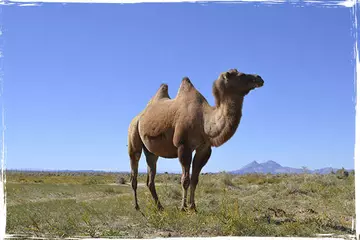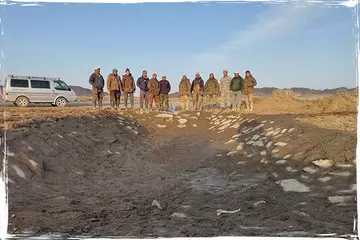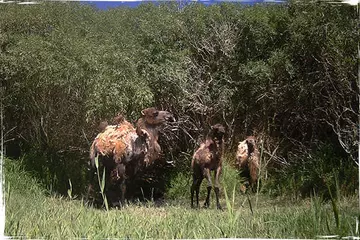
Wild camels are some of the most resilient creatures on earth.
Perfectly evolved for survival in the harsh Gobi Desert, they can cope with temperature ranges of -40 to 40C, go for days without food, and search for thousands of miles to find water.
But they are also the 8th most endangered mammal on the planet, with less than 1,000 now left in the wild. We chatted to ZSL's Bolor Radnaabazar, Tungaa Ulambayar and Bilguun Batkhuyag in Mongolia to find out why your support is so crucial…
Firstly, is there any such thing as a wild camel? How is it different from the usual two-humped variety?
If you’ve never heard of wild camels, you’re certainly not alone – in fact, they weren’t recognized in the Western world until quite recently! While wild camels are still often mistakenly said to be descended from Bactrian camels and may look quite similar (both have two humps), they’re actually a totally separate species.

How many wild camels are there?
There are 35 million domesticated Bactrian camels in the world, compared with only 950 wild camels, scattered in small groups across northwest China and southwest Mongolia. That tiny number makes it really important to distinguish between the two – so we can help wild camels get the conservation attention they desperately need.
What is the ZSL team doing in Mongolia?
Since 2018, we’ve been working in the vast untouched wilderness of the Great Gobi ‘A’ Strictly Protected Area (GGASPA), a protected area of the Mongolian Gobi Desert that is home to half the world’s remaining wild camels. Because wild camels are the umbrella species of the Great Gobi, our work to study and conserve them also benefits many other species in their habitat range: the Asiatic wild ass, Black-tailed gazelle, Gobi bear and snow leopard, to name a few!

We work closely with traditional pastoral and herder communities and government partners to make sure our work has a positive impact on the entire desert ecosystem, including the Gobi people who depend on it.
Continued from your Back from the Brink email…
What makes wild camels so special?
Wild camels are incredibly resilient and charismatic creatures. They are superbly adapted to the harsh Gobi environment with scarce vegetation and water, and sharp temperature fluctuations ranging between -40°C to 40°C – and can forage on thorns and dry, salty plants that are not palatable for other grazers. They can go for several days at a time without food and water, and once they access a water source, can drink up to 57 litres in one go!

Why has the population suffered such a dramatic decline?
Sadly, wild camels face multiple threats. The four biggest ones are water scarcity, forage shortage, predation and disease. The effects of climate change (warming weather, reduced rainfall, drying-up water sources and more frequent drought) along with overgrazing and competition mean water and food are becoming even harder to find. Livestock numbers in buffer zones have doubled in the last two decades. At the same time, the decline of other species makes wild camels a target for predators, and water pollution is contributing to the spread of disease.
How are donations making a difference?
Some of the key things our team is focusing on – with the help of passionate ZSL supporters – are:
- Gathering more accurate information, on things like camel numbers, migratory paths, water sources and predator/prey relationships.
- Testing models to restore water sources and tree species (forage for camels).
- Reducing human pressures through awareness-raising and better land management.
In October 2022, we completed the installation of four solar-powered pumps and the construction of a reservoir in Great Gobi A Strictly Protected Area and its buffer zone. This should increase access to water for wildlife across the dry and harsh Gobi desert, and we’re monitoring this with camera traps at the water points.

It’s very much a work in progress, but when complete, we hope to stabilize and even increase the world’s wild camel population. Along the way, we also aim to inspire Gobi children, communities and government colleagues with ZSL’s vision of a world where wildlife thrives.
FIND OUT MORE ABOUT OUR WORK IN MONGOLIA
